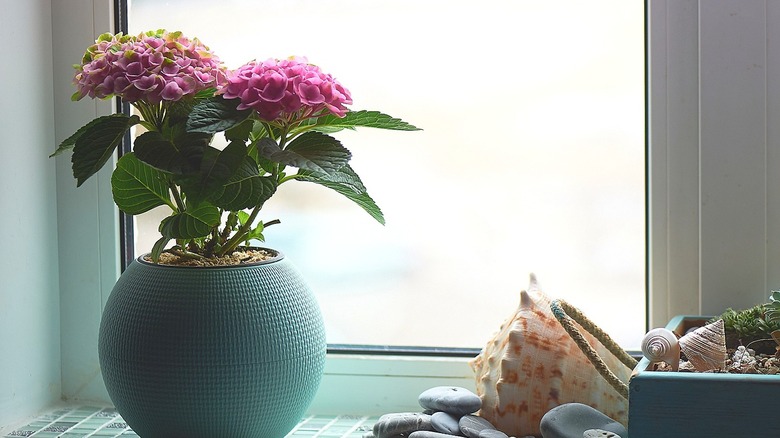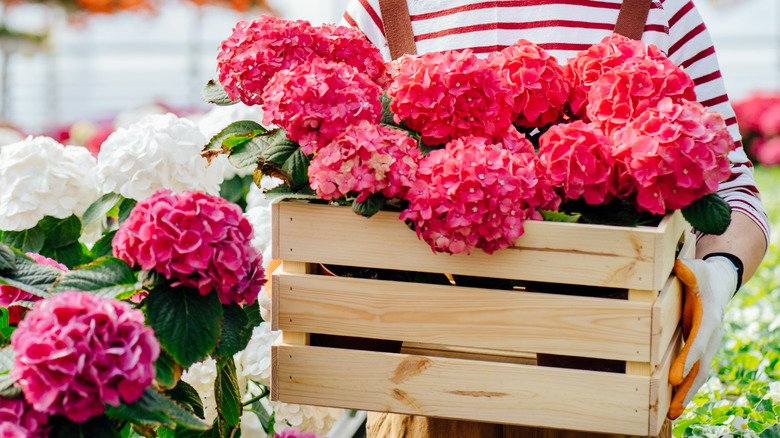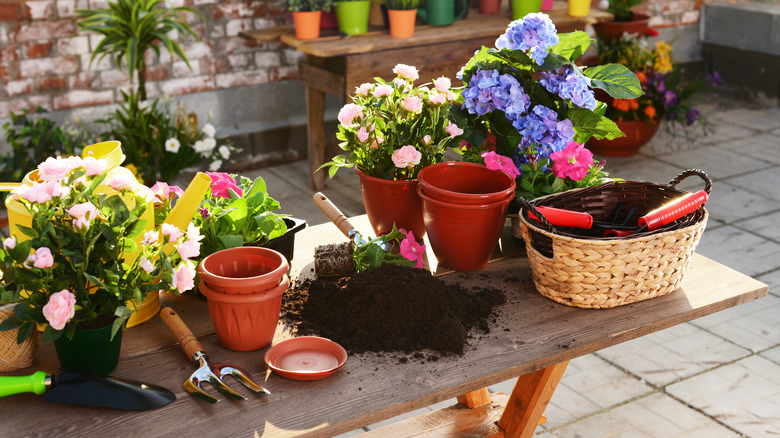How To Grow And Care For Hydrangeas Indoors
Showy yet subtle, hydrangeas augment gardens, borders, and foundation plantings with their beautifully rounded clusters of flowers. Outdoors, these perennial shrubs bloom in late spring and early summer, reaching a height of 3 feet and a width of up to 3 feet. Indoors, you can grow these bright, flowering globes as well; you'll just want to cultivate a smaller hydrangea plant, which can then bring your home color and texture year-round.
Hydrangea macrophylla, best known as the mophead hydrangea, is one of the easiest varieties for growing indoors. Like any potted plant, hydrangeas depend on you for the correct light, moisture, temperature, and soil. Specifically, hydrangeas prefer bright, indirect sunlight for several hours daily. The soil should be consistently moist but not sopping, since too much water will make the roots rot. They prefer cooler room temperatures but not cold, drafty indoor spaces.
Hydrangeas are somewhat flexible when it comes to their potting soil, adapting to loam that's slightly acidic or slightly alkaline. Not only can you have fresh, blooming flowers throughout the year, but there are also dozens of websites with ideas for working with dried mopheads, using them in attractive arrangements for centerpieces, or in crafts, such as wreaths.
Moisture and soil
Humidity and moisture are big issues for all indoor plants, but especially for flowering plants. Think of potted hydrangeas as thirsty, but poor swimmers. For a watering schedule, consider watering your hydrangeas every other day or about three times a week, always monitoring to ensure the soil doesn't run dry. Proper drainage is also necessary for the health of a potted indoor hydrangea. You could also use a mister on the flowers, buds, and branches, making sure the water trickles down the stems into the soil. It's the equivalent of your hydrangea taking a refreshing shower.
That big, blooming ball is actually a cluster of white, pink, blue, or purple flowers, and soil acidity has a lot to do with which color you see. We've described how to measure the soil's pH — with or without a testing kit — but no matter how you determine the pH of your hydrangea plant's soil, just remember that a result above 7 means alkaline soil, and below 7 is acidic.
For hydrangeas, the element aluminum, combined with acidic soil, is what turns hydrangeas blue. Both conditions are necessary to produce this color. If the soil is alkaline, expect pink hydrangeas. Indoors, you can completely control the pH level by using the correct pH potting soil to increase your odds of getting the hydrangea color you prefer (along with the presence of aluminum). Note, too, there are new hybrids like "Vanilla Strawberry" and "Little Lime Punch" with flowers that are deliberately and gorgeously two-toned.
Light and temperature
When you see a thriving hydrangea outdoors, you're probably seeing it in a place with mature trees overhead. Tall trees filter the sunlight, so the shrubs don't burn up. Indoors, the same principle applies. Establish your potted hydrangea in a place that gets morning sun or sustained southern-facing sun for about four hours but keep the plant out of direct sunlight. Watch the edges of the leaves. If they start to crimp and turn brown, your hydrangea is getting a sunburn, and you need to give it more protection.
Flowering plants do best in a cooler temperature, especially when the flowers are at their peak. When an indoor hydrangea is in bloom, keep it in the coolest place in the house. You may need to place it outside, depending on the weather. As a perennial, hydrangeas do best if you give them a period of dormancy, and this is after they have bloomed, between fall and winter. Place the potted plant in an area that's cool, say 50 degrees, and keep the soil moist.


